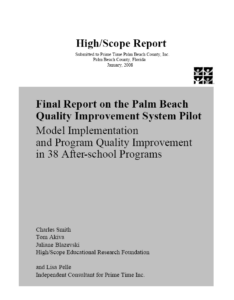This report on the Palm Beach County Quality Improvement System (QIS) pilot provides evaluative findings from a four-year effort to imagine and implement a powerful quality accountability and improvement policy in a countywide network of after-school programs. The Palm Beach QIS is an assessment-driven, multi-level intervention designed to raise quality in after-school programs, and thereby raise the level of access to key developmental and learning experiences for the youth who attend. At its core, the QIS asks providers to identify and address strengths and areas for improvement based on use of the Palm Beach County Program Quality Assessment (PBC-PQA)—a diagnostic and prescriptive quality assessment tool – and then to develop and enact quality improvement plans. Throughout this process training and technical assistance are provided by several local and national intermediary organizations.
We present baseline and post-pilot quality ratings for 38 after-school programs that volunteered to participate in the Palm Beach QIS pilot over a two-year cycle. This data is the routine output from the QIS system and is designed to support evaluative decisions by program staff and regional decision-makers. In addition to the typical QIS output, we also provide as much detail as possible about the depth of participation in the various elements of the improvement initiative and offer a few opinions about what worked.
Primary findings include:
- Quality changed at both the point of service and management levels. During the QIS quality scores changed substantially at both the point of service and management levels, suggesting that the delivery of key developmental and learning experiences to children and youth increased between baseline and post-pilot rounds of data collection.
- Point-of-service quality increased most substantially in areas related to environmental supports for learning and peer interaction, but positive and statistically significant gains were evidenced in all assessed domains of quality.
- The incidence of organizational best practices and policies increased in all assessed management-level domains, especially staff expectations, family connections and organizational logistics.
- Planning strategies that targeted specific improvement areas were effective. Pilot sites registered larger quality gains on point of service metrics that were aligned with intentionally selected areas for improvement. This indicates that the quality improvement planning process effectively channels improvement energies.
- Site managers and front line staff participated in core elements of the QIS at high rates. Relative to other samples, participation by front line staff was especially high, suggesting that the core tools and practices of the QIS are reasonably easy for site managers to introduce into their organizations.
- The core tools and practices of the QIS were adopted at high rates. Thirty-five of 38 sites (92%) completed the self-assessment process and 28 sites (74%) completed all of the steps necessary to submit a quality improvement plan.
Several secondary questions posed by stakeholders or relevant to policy were also explored. These secondary findings must be treated with caution since they are drawn from a small sample and, in some cases, less than perfect data sources. Secondary findings include:
- The low stakes approach to accountability within the QIS model appears to have increased provider buy in. Through review of secondary documents and quantitative data, the QIS emphasis on partnership rather than external evaluation achieved buy-in from pilot group providers for the self-assessment and improvement planning process.
- The self-assessment and improvement planning sequence was associated with change in quality scores. Programs that participated in the self-assessment process were more likely than those that did not to experience improvement in their quality scores.
- Structural characteristics such as organization type, licensing status, supervisor education and experience levels were not strongly related to point-of-service quality. This suggests that the variables most often manipulated by reform initiatives are, at best, weak drivers of setting quality and thus less-than-ideal policy targets. Put another way, these several program “credentials”, while reasonably easy to measure, were poor proxies for quality.
Smith, C., Akiva, T., Blazevski, J., & Pelle, L. (2008). Final report on the Palm Beach Quality Improvement System pilot: Model implementation and program quality improvement in 38 after-school programs. Forum for Youth Investment, David P. Weikart Center for Youth Program Quality.
